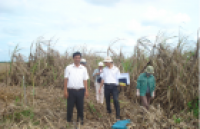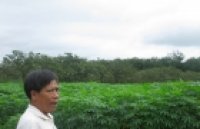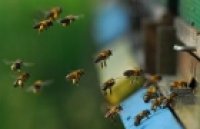| Identification of genetic loci associated with five agronomic traits in alfalfa using multi-environment trials |
|
Yield is one of the most important target traits in alfalfa breeding; however, yield is a complex trait affected by genetic and environmental factors. In this study, we used multi-environment trials to test yield-related traits in a diverse panel composed of 200 alfalfa accessions and varieties. Phenotypic data of maturity stage measured as mean stage by count (MSC), dry matter content, plant height (PH), biomass yield (Yi), and fall dormancy (FD) were collected in three locations in Idaho, Oregon, and Washington from 2018 to 2020. |
|
Sen Lin, Cesar A. Medina, Guojie Wang, David Combs, Glenn Shewmaker, Steve Fransen, Don Llewellyn, Steven Norberg & Long-Xi Yu
Theoretical and Applied Genetics May 2023; vol. 136, Article number: 121 Published 29 April 2023
Figure: Alfalfa (Medicargo sativa L.) is also called lucerne.
Key MessageThe use of multi-environment trials to test yield-related traits in a diverse alfalfa panel allowed to find multiple molecular markers associated with complex agronomic traits. AbstractYield is one of the most important target traits in alfalfa breeding; however, yield is a complex trait affected by genetic and environmental factors. In this study, we used multi-environment trials to test yield-related traits in a diverse panel composed of 200 alfalfa accessions and varieties. Phenotypic data of maturity stage measured as mean stage by count (MSC), dry matter content, plant height (PH), biomass yield (Yi), and fall dormancy (FD) were collected in three locations in Idaho, Oregon, and Washington from 2018 to 2020. Single-trial and stagewise analyses were used to obtain estimated trait means of entries by environment. The plants were genotyped using a genotyping by sequencing approach and obtained a genotypic matrix with 97,345 single nucleotide polymorphisms. Genome-wide association studies identified a total of 84 markers associated with the traits analyzed. Of those, 29 markers were in noncoding regions and 55 markers were in coding regions. Ten significant SNPs at the same locus were associated with FD and they were linked to a gene annotated as a nuclear fusion defective 4-like (NFD4). Additional SNPs associated with MSC, PH, and Yi were annotated as transcription factors such as Cysteine3Histidine (C3H), Hap3/NF-YB family, and serine/threonine-protein phosphatase 7 proteins, respectively. Our results provide insight into the genetic factors that influence alfalfa maturity, yield, and dormancy, which is helpful to speed up the genetic gain toward alfalfa yield improvement.
See https://link.springer.com/article/10.1007/s00122-023-04364-4 |
|
|
|
[ Tin tức liên quan ]___________________________________________________
|


 Curently online :
Curently online :
 Total visitors :
Total visitors :
.png)


